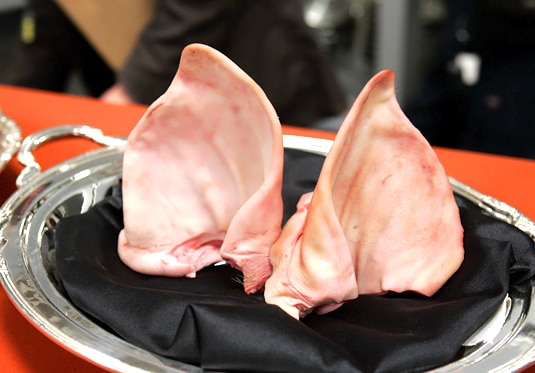Inner Beauty
Two weeks later, James Oseland is still contemplating why the chefs had such an offal time.

It’s been a couple weeks since the offal street-food episode aired, and I still catch myself wondering, "Why did these amazingly talented chefs have such a hard time with this challenge?" I mean, offal and street food go hand in hand all over the world, from Florence (where my favorite quick lunch is a sandwich from one of the many tripe carts around the city) to Morocco (where calves’ feet stew is a fortifying street-food breakfast). And besides, offal and street food have both been enjoying a renaissance here in the States. So, what was the problem?
To their credit, all the chefs were deft and enthusiastic when it came to working with their assigned organ meat. Things fell apart only when they stepped up to the carts. It seemed to me that many of these chefs would have had no problem whatsoever crafting hearts and lungs and other innards into fancy restaurant dishes, but when presented with catering to a crowd on the street at Universal Studios, they were flummoxed.
Granted, the whole concept of street food is a bit elusive. If you go to certain places in Southeast Asia, “street food” can be anything from elaborate meals of curries and stir-fries to simple fried noshes. In Mexico, the range is just as broad. Because offal is inexpensive and widely consumed in homes in those parts of the world, it fits right into the casual nature of street-food meals. In fact, many of the dishes in The Fifth Quarter, Annisa Helou’s awesome cookbook devoted to offal (the name comes from il quinto quarto, which is how Italian butchers refer to innards) are street-food classics.
In Europe and America, street food has typically amounted to not much more than a hot dog or maybe a gyro (or, if you’re lucky enough to live in Los Angeles, a taco from a taco truck). But nowadays you can find vendors in cities across the States who sell Belgian waffles or dosas or porchetta sandwiches or barbecue. Though they’re the exception to the rule, they’re extremely popular, and for good reason. The cooks do one thing really, really well.Ludo’s problem wasn’t just that he got stuck with the pig’s ear (arguably the most challenging of the meats on the table) but that, instead of cooking what he knew, he reached for a quick (and, ultimately, self-defeating) street-food cliché: a quesadilla. It represented a failure of the imagination, and it tasted like a grilled cheese sandwich. The beautifully cooked pig’s ear was detectable only as a mysterious chewy bit that made itself known every chomp or two. Why such subterfuge? Why Wilo reached for a dry, chewy pita rather than the traditional baguette for his tripleta is likewise a mystery. Cindy’s menudo was a great idea, but it lacked, I don’t know … guts. It tasted like menudo “lite” — it didn’t have the kind of gusto, the delicious slurpiness, the salt and spice and astringency, that can bring that dish to life.
The one chef who seemed to be completely at ease with this challenge was Rick. And why not? What has Rick been doing all these years if not translating his love of Mexican food — and, in many cases, street food — for an American audience? Rick’s tongue taco was the only dish that exuded confidence and verve.
A chef has to be wary of catering too much to the customer instead of making food that he or she knows and trusts and loves. If the chef loves it, the customers are going to love it, too.
Maybe, if these chefs had had more time to plan, we would have seen some stir-fried noodles with Asian greens and julienned offal or a quick pig’s ear terrine on a baguette that would have blown our minds. Maybe next time.



